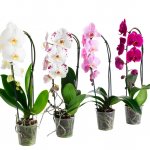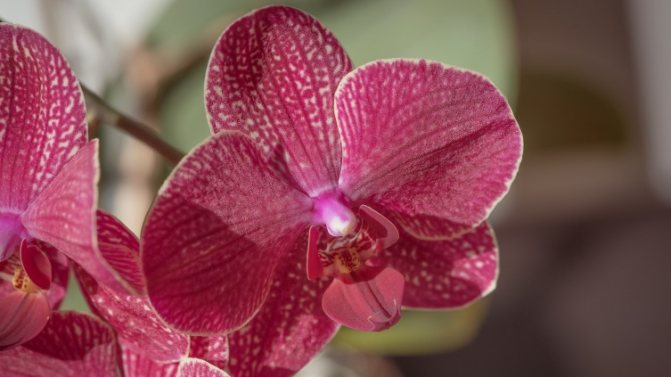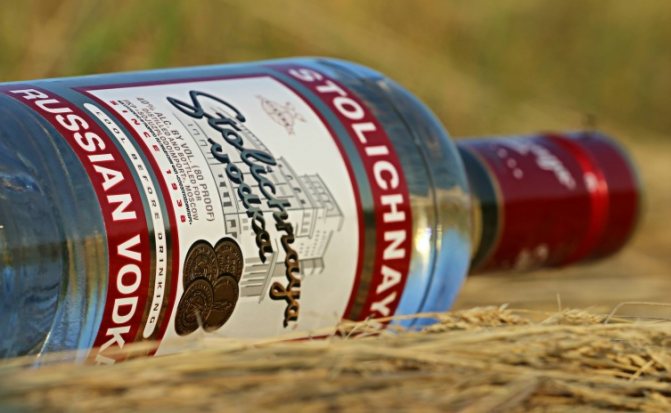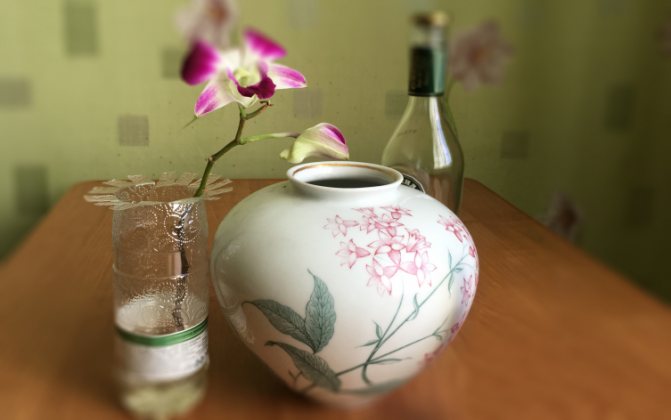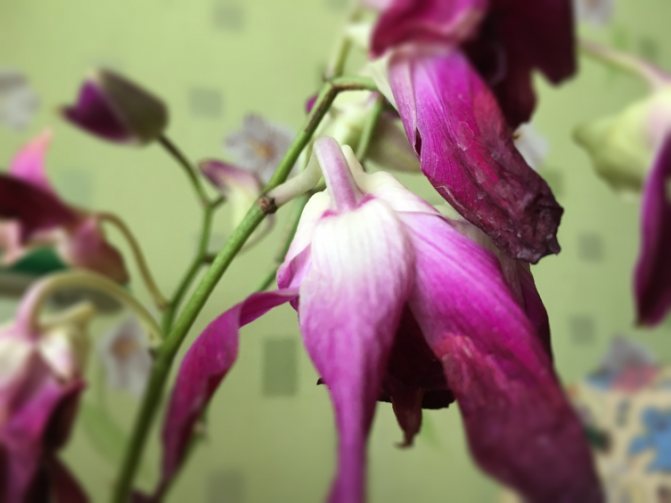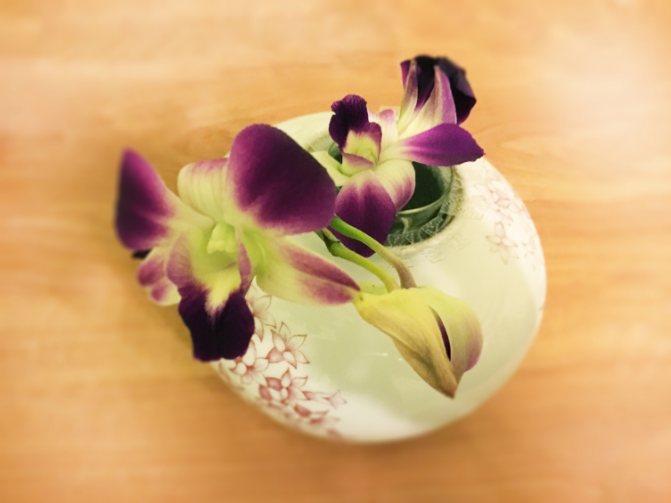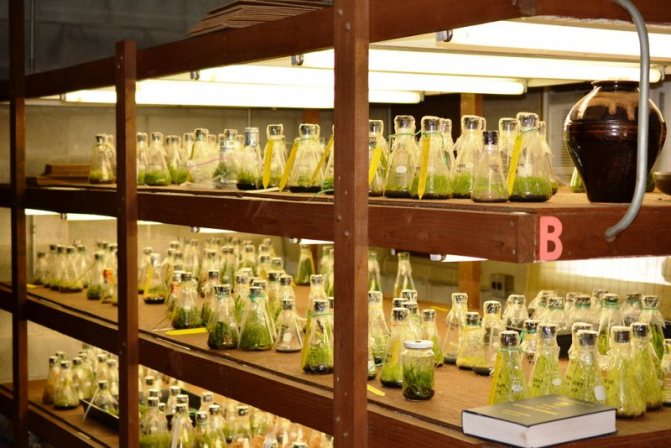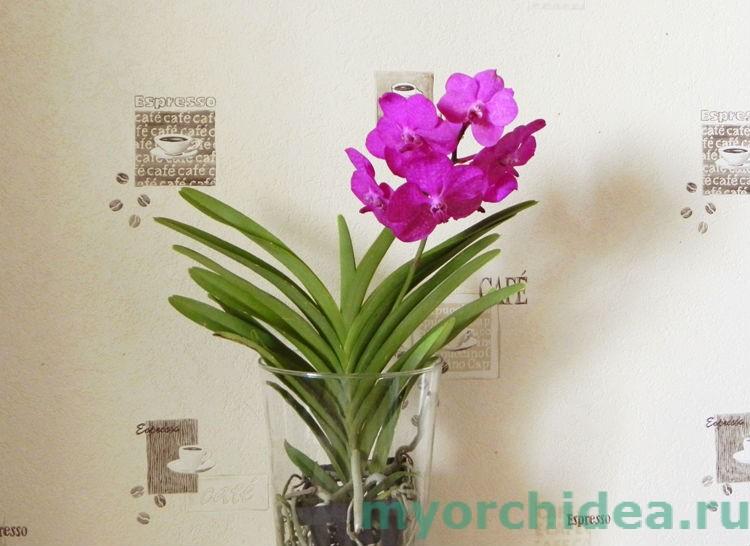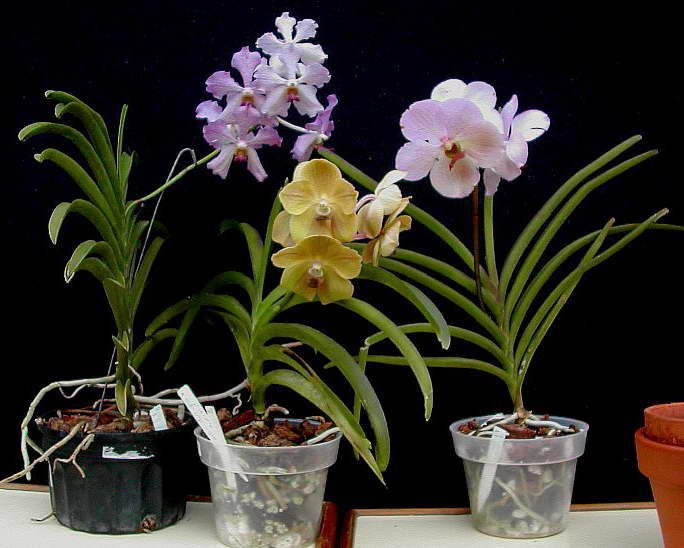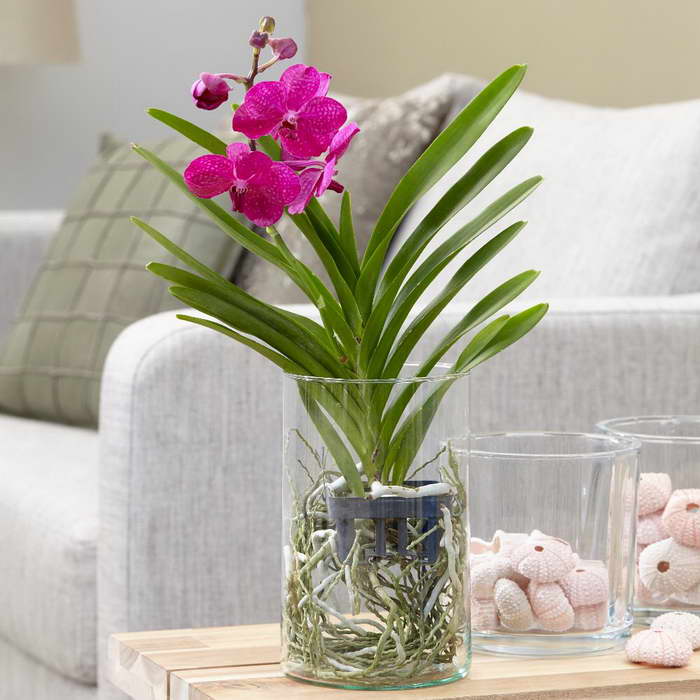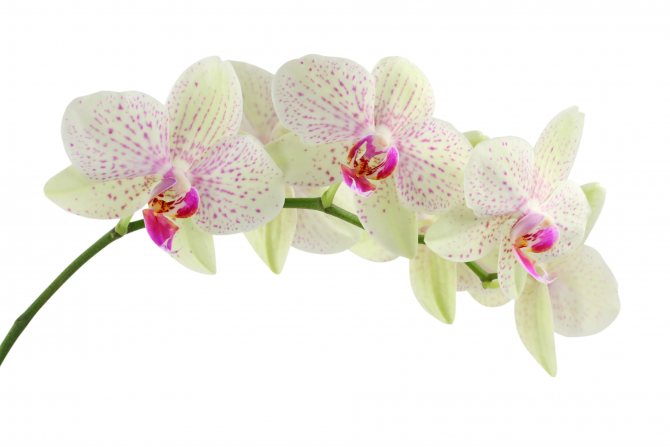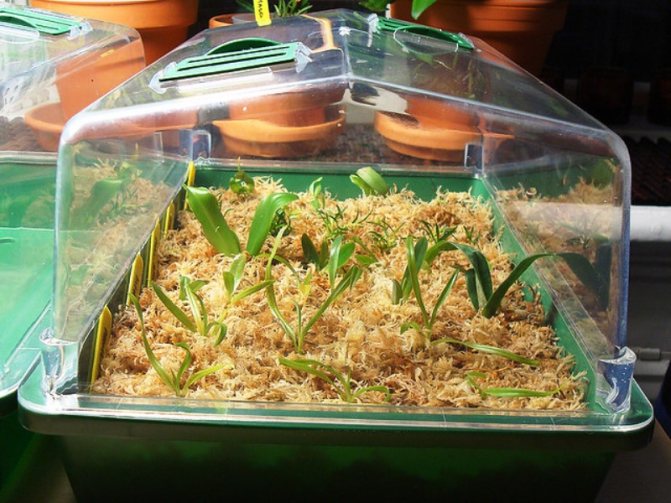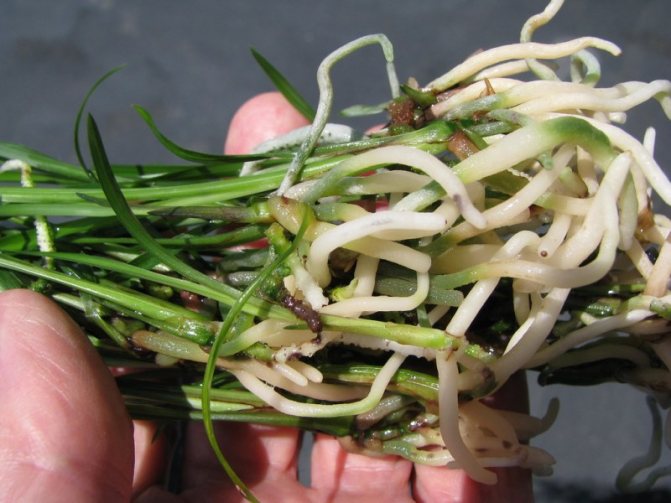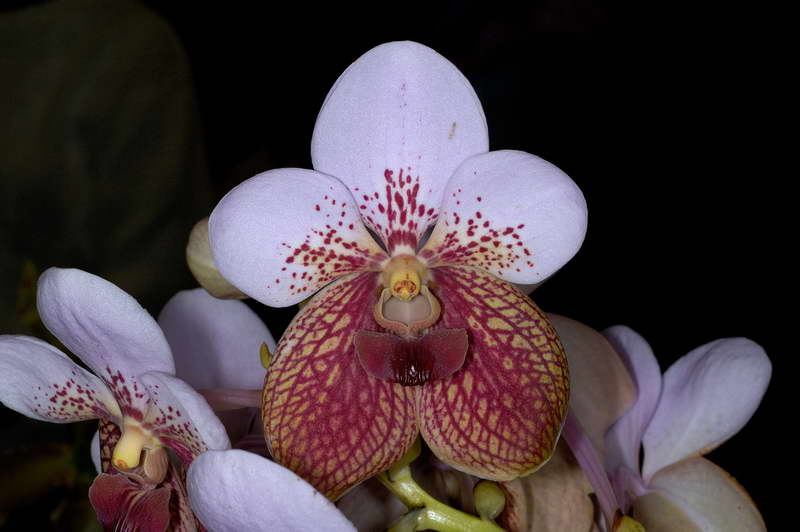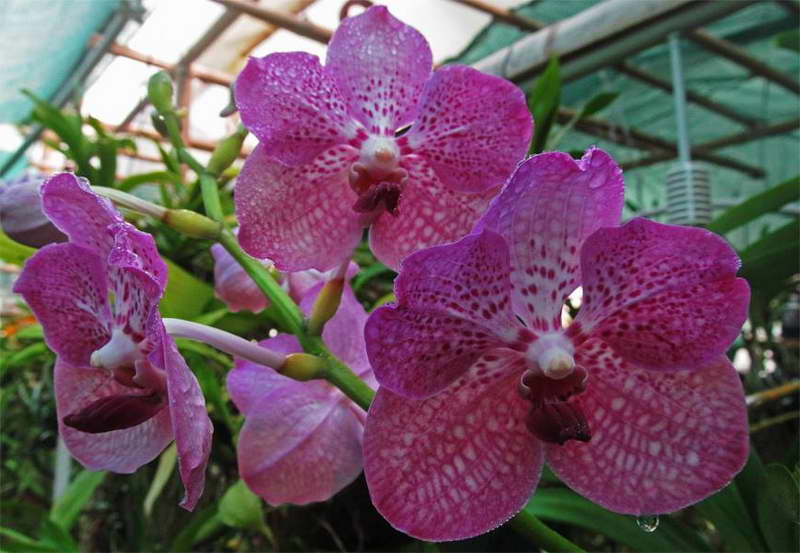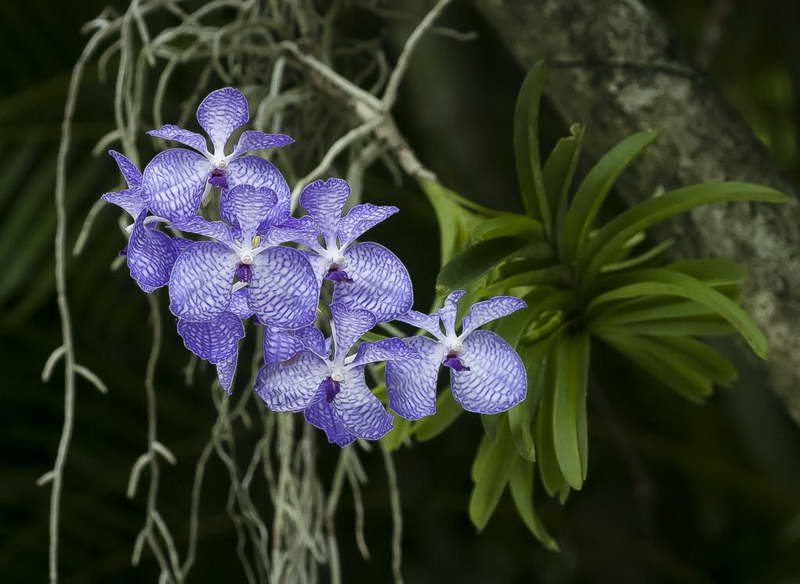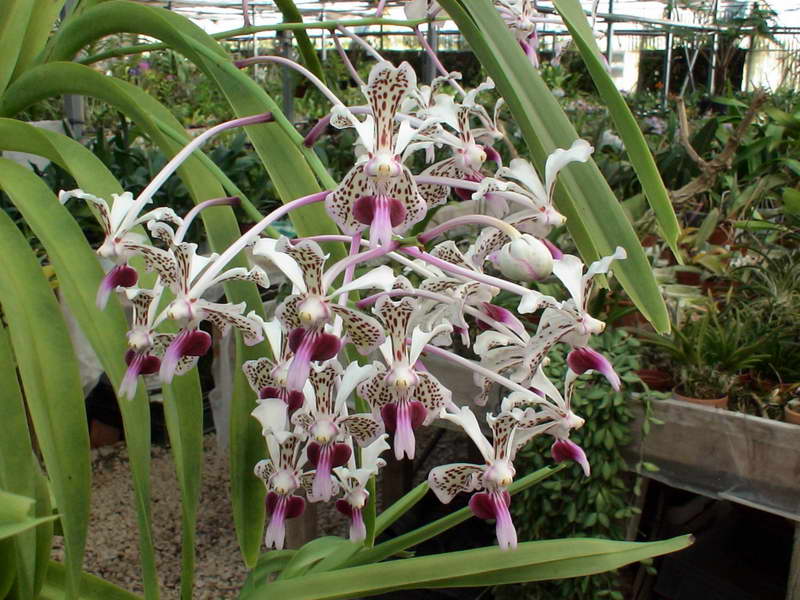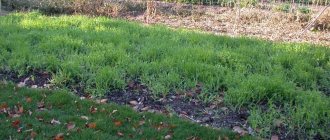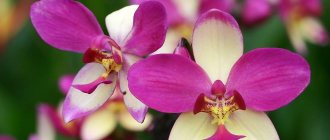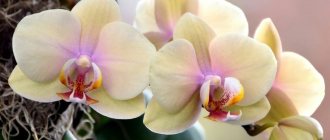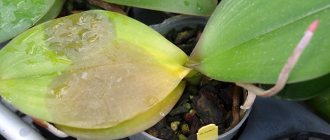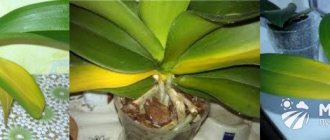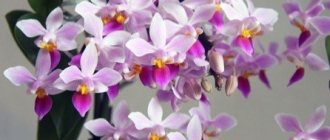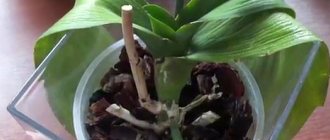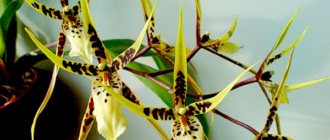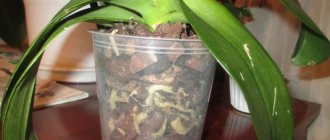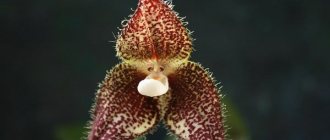The orchid is a very whimsical flower, so in order for it not to wither, you need to know the basic rules of home care, how and how much to water. And also you will learn in our publication how to care for a cut orchid.
Flower delivery will help you become the owner of an orchid. You can order flowers in pots or a beautiful bouquet at a reasonable cost. The order will be delivered exactly at the time agreed with the customer. Having received an orchid as a gift, I want it to delight with its flowering for a long time.
General concept
Forms, descriptions, container material
Tribes living in the jungle of South America are called orchids "Daughters of the air"... This expression is the true meaning of the lifestyle of most tropical orchid species.
Therefore, you should immediately make a reservation that growing exclusively inside flasks - not suitable for orchids, moreover, it is contrary to their nature.
However, in flower shops there are epiphytic orchids, the same vandas sold in a glass flask. BUT orchid seeds in culture are germinated in sterile, sealed containers - bottles, jars and laboratory glassware.
Thus, we can say that most often there are flasks of a simple shape in the form of an elongated glass beaker or a complex, "traditional" shape with a flat bottom and a narrow neck.
Neither one nor the other is suitable for normal cultivation. As the plant will suffer from constant stuffiness, being in danger of decay. It is necessary to find a wide flask in the shape of a cognac glass.
What types of orchids can grow in glass?
Traditional, so to speak, cultivation in a flask for aesthetic and practical reasons implies the absence of a substrate or its replacement with a hydrogel.
therefore epiphytic / lithophytic orchid species that have a highly developed root system can grow in flasks... Considering also the fact that the bulb is elongated upward, upward growing monopodial species are preferred:
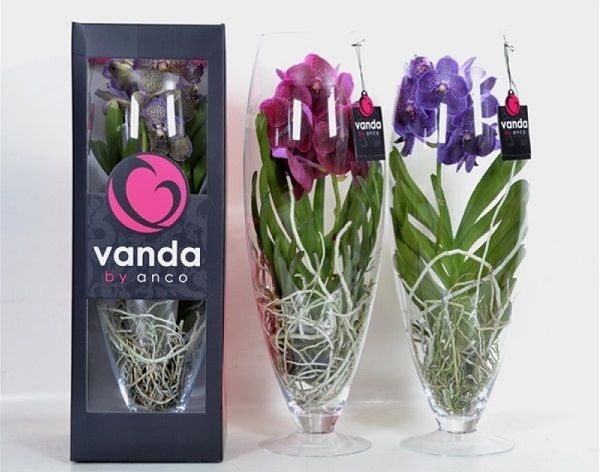
Wandas in glass vases.
What's the best way to arrange the flower?
The plant is placed in a flask by half. That is, inside a suitable-sized "glass" are placed orchid roots only... The plant itself is on the surface, in the open air. The base of the rosette should be flush with the edges of the vase. and not be buried inside. You can fix the plant in this position with wire or any other available methods and materials at hand.
Growing seedlings and an adult plant
A flask for an orchid is not quite a “flask” in the traditional sense of the word. The capacity is tall vase of cylindrical or complex shapethat looks like a glass or goblet. They are made of glass and very rarely of plastic.
For germination of seedlings, as usual, various glassware is used, ranging from bottles and jars to laboratory glassware of all shapes and sizes. The only conditions for which are: transparent glass and the possibility of hermetic sealing.
These flasks are a temporary shelter for orchids., since germination does not depend on the volume of dishes, and, at the same time, requires sterile conditions. Such containers are not suitable for growing adult plants., at least one parameter - size. Considering the complex shape, fragility of thin glass and the presence of narrow necks, you can safely delete them from the list of candidates for the "habitation" of the orchid.
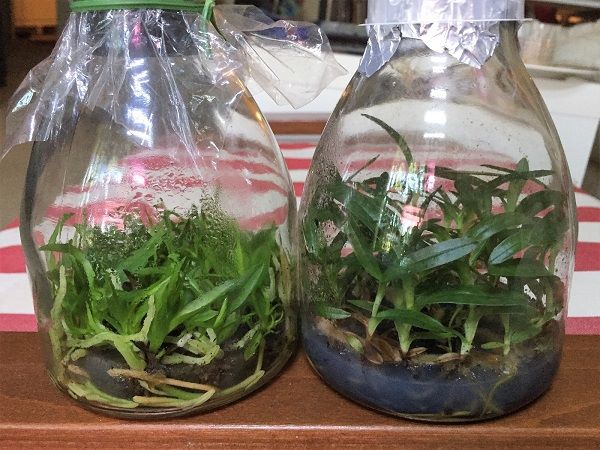

Orchid seedlings in a flask.
As has been repeatedly noted above, for an orchid it is necessary to find a flask of a suitable size, similar in shape to a cognac glass. And even if the blooming vanda behind the glass of a tall, glass-like flask looks very elegant, this content suits her only conditionally.
Care features
When growing orchids in a vase, you need to pay special attention to watering. The procedure is different from that for potted flowers. It is not recommended to leave water in vases, otherwise excess water will lead to the death of the flower's root system. Usually the plant is given 20-30 minutes to "quench its thirst", after which the remaining water is poured out of the flowerpot. Water for irrigation should be soft; it is allowed to mix ordinary tap water with distilled water in a 1: 1 ratio. In the summer, orchids are watered every other day, but not allowing the soil to become waterlogged. In winter, one watering per week is enough.
In order for the vanda in a glass vase to grow well, bloom abundantly and regularly, the flower must be fed. To do this, it is enough to add a little fertilizer to the water for irrigation.
Do not forget about spraying. For these purposes, a conventional spray gun is suitable. In the summer, this procedure must be carried out at least three times a day. It is better to spray the flower in the morning, so that by the evening the leaves of the plant have time to dry out.
When caring for your orchid, remember that it loves light, however, direct sunlight should be avoided. South-facing windows are ideal for the location of the flower. If it is not possible to provide the flower with sufficient amounts of solar color, additional artificial lighting is used. With a lack of light, the plant may die.
Orchids are prone to fungal diseases. To prevent this, it is necessary to remove dry and broken roots in time. Fortunately, they are clearly visible in vases and the danger can be noticed in a timely manner. If you see that the leaves turn yellow or fall off, cut off the affected area and treat the area with iodine or brilliant green.
If you follow the above conditions of care, add love, attention, care to them, then a wanda in a glass vase will give you the opportunity to enjoy the beauty of flowering up to 3-4 times a year.
We transplant the orchid into a new glass pot, advice from experienced ones.
To begin with, I suggest that you familiarize yourself with the general information on the transplant. As you can imagine, if the pot becomes too small for your flower, it's time to transplant it. A transplant is also needed if there are any problems and damage to the root system. Well, someone just wants to change the old vessel for a new one, more beautiful and suitable for interior design in the house. By the way, and for lovers of glass / transparent plastic containers.
In the case of a transplant, the main problem is not a process at all, but a result. In order not to mislead you with the title of the article, I will of course put in a word about the transplant itself. How much without her. But before the transplant itself, it will be useful to know a few things to begin with.
When the flowerpot is completely filled with roots, they begin to displace the soil. In the case of an orchid, roots can grow above the surface of the ground, and this is absolutely normal for a healthy flower. And they can be damaged if you plant an orchid in the wrong ground or water it incorrectly. In the event that the roots began to rot or dry out, and even more so, to die off, it is necessary to urgently transplant the flower. If everything is in order with your roots, then the best time to transplant is the end of flowering.
Is it necessary to transplant an orchid into a transparent one?
How do you know if you need to transplant an orchid? If the earth has crumpled and settled and there is a free space around the roots, if you smell rotting, damp mold, and in general it smells differently than usual, if the pot is noticeably heavier, if the green roots have become gray, brown or some other incomprehensible dark colors and also began to rot, then it's time to start transplanting.
Transplanting an orchid into a glass pot
Carefully remove the orchid from the old pot. If you have a plastic pot, it's better not to be afraid to break it than to damage the delicate roots of the flower. Then place the orchid in a small bowl of warm water and leave it there to soak. With the help of a shower, it will be necessary to wash off the soil from the roots. Of course, not so that they shine, but the main thing. Consider the roots, if they are rotten, damaged, and if so, they should be carefully cut off and sprinkled with charcoal. In order for the roots to dry out, the flower can be placed on a napkin or paper towel.
While the orchid is drying, you need to prepare the ground for a new pot. Since we are talking about a glass pot, it is very important to follow all the rules so that the drainage is done wonderfully well. After all, even if your glass pot has holes in the bottom, moisture evaporation in it will be completely different. Lay a layer of ceramic shards (you can also expanded clay) up to 5 cm high. This will allow the water to freely reach the bottom of the pot without stagnating. Then we fall asleep the prepared soil and put our dried plant in it. It is better to buy special earthen mixtures for orchids, because they take into account the peculiarities of the roots.
Features of watering and caring for an orchid
After you have planted your orchid in glass and in the absence of holes in the vase / vessel, you can only water it from above. It will not be difficult to do this, control the amount of water - too, because your pot is now transparent. The main thing is not to overflow or dry out the plant. Since the ground on the surface will dry out much faster than inside your newfangled pot. To do this, the surface of the earth can sometimes be sprayed from a spray bottle.
If you suddenly decide to propagate it when transplanting, well, you can do it at the expense of the main plant. But it's better to read a separate specialized article about this in advance, and not experiment while replacing the pot. In general, an orchid can be divided into parts with roots. At the same time, after transplanting, do not forget to leave the orchid alone, while it can only be sprayed every day. But don't water. In general, the complexity. Therefore, it is still better to allocate a separate time for reproduction.
What if, as a result of all your experiments, the orchid has lost up to 95 percent of its roots? Is there a chance to save the plant? Chances are small, of course, but try it. To do this, just like for a transplant, you need to rinse the roots, find the dead, cut them off and sprinkle them for healing. The method of salvation itself is not so much complicated as it is time-consuming. Since you will have to soak the roots alternately and then dry them.
Experienced tips
- If your orchid suddenly did not like its new place of residence, as an option, you can take it along with the pot to the workshop and ask to drill a hole in the glass. Then place the pot in the water. This will help the orchid come to life.
- Even if you follow all the watering rules, the pot will still turn green from the inside. And little of the transparency will remain of it. You will not look at the cute roots of the orchid, but at the greenery. And here it is not only about humidity, but also about exposure to light. Although this greenery does not harm orchids. If you are not bothered by this development of events, you can leave it that way.
Someone generally suggests not to scoff at the plant and plant it in a well-ventilated plastic pot, well, and they are certainly right.
- What to do if Zamioculcas leaves turn yellow and pests appear?
- Indoor flower Camellia - home care, photo.
An orchid in a glass vase, flask or pot is a great addition to the interior
and its decoration that will be appropriate both at home and in the office setting. In addition, this item is often chosen as a gift.
How to care for an orchid in a flask?
Orchid content in a vase has its own advantages and disadvantages. Behind the glass flasks a humid microclimate is formed and maintained, which in turn is very useful for the root system of the epiphyte, since in nature they grow in just such conditions.
At the same time, a significant disadvantage is rapid cooling of the glass, which can cool the roots. And cold and moisture, as you know, are very harmful to the roots of orchids, they can provoke the appearance of mold and rot.
In addition to the low thermal conductivity of glass, it goes fragility and high contamination rate - limescale, colonies of algae and fungi.
It is necessary to know about all these features of materials and forms before placing a plant in such a container. If this did not stop the grower and a similar experiment is planned, you also need to know about proper care in specific conditions.
Watering
The watering procedure is no different from if the grower did it with a plant in a pot and a pots. It is necessary to carefully pour water into the flask so that all the roots are immersed. After 30-45 minutes, the water must also be carefully drained. Use rainwater, thawed or filtered water with a minimum amount of dissolved mineral salts.
After draining the water, make sure that it does not remain in the vase. Watering is carried out as needed, depending on the condition and requirements of the plant. On average, this is 2-3 times a week in warm weather and 1 time in cloudy. On especially hot days, the frequency of watering can be daily. Watering is carried out in the morning, so that the plant has time to dry out by night.
Airing
Fresh air is extremely important for epiphytes. It is necessary to periodically ventilate the plant.... The size of the container should be sufficient so that the roots of the orchid fit freely inside, can be ventilated, and air easily gets inside.
Flask disinfection
Over time, the glass of the container becomes covered from the inside with a layer of algae, fungi or a coating of salts. For this reason the flask has to be constantly washed and kept clean.
Disinfection can be carried out with a weak solution of potassium permanganate. For the duration of the procedure, remove the plant from the container.
Sometimes orchid roots stick to the sides of the vase, so be careful when removing it.
Top dressing
Epiphytic orchids in nature feed on humic substances that collect in the cavities of the bark of trees or between stones. In culture, these plants, like no other, need competent feeding.
During the active growing season and a set of green mass, feed the orchid with liquid fertilizers at ¼ of the concentration indicated on the package. Before the procedure, it is necessary to moisten the roots of the plant with clean water - this measure is necessary in order to exclude the possibility of burning the delicate root system with a solution of fertilizers. Such feeding can be alternated with foliar dressing "on the sheet".
Disease prevention
The best prevention is keeping the plant in proper conditions and maintaining its hygiene. Care must be taken that the orchid receives a sufficient amount of light, especially in winter, when the duration of daylight hours is sharply reduced. Hypothermia of the root system, dirt and debris inside the flask are also unacceptable. Remove dead plant roots and leaves in a timely manner.
Fungicide treatment
Conducted for preventive purposes systemic fungicides according to the instructions.
Due to improper watering, orchids can rot roots or leaves.
If the plant was nevertheless infected with bacteria or fungi, treatments are carried out in treating dosages.
Infectious Disease Risks
The reasons
The cause of this kind of disease is accumulation of pathogens: fungi and bacteria.
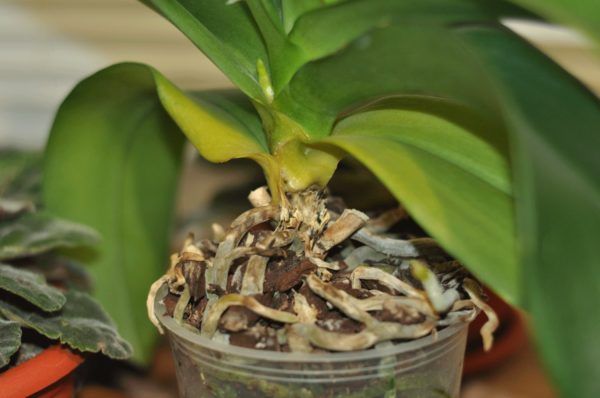

To prevent diseases of the orchid, it needs proper care.
It is enough to imagine a damp basement in a building or a corner of a house on the north side to understand how this happens. Fungi or bacteria gather and breed in damp, secluded places. A glass vase, where there is no ventilation of any kind, is the ideal place in this case.
Prophylaxis
It is necessary periodically air the plant and the capacity itself. Fresh air is essential for epiphytes. In turn, this minimizes the possibility of:
- Stagnation of moist air inside;
- And the appearance of mold, fungus and bacterial colonies.
It is also very important to keep the plant in acceptable conditions for him, i.e:
- Provide adequate lighting;
- Optimal temperature conditions;
- And watering.
Treatment
The vase must be washed periodically, since accumulates on the inner walls:
- Algae layer;
- And mineral deposits.
Disinfection procedure or prevention can be done with:
- A weak solution of potassium permanganate (of course, the plant should be removed);
- Or fungicides.
Orchids in a flask
A flask or a bottle (from the Latin flasco - "vessel for wine") is a small container that is used to store liquids and other substances. In the context of growing orchids Flask refers to glass or plastic bottles with seedlings and adolescents. This capacity is temporary and is only suitable for germinating seeds and growing seedlings.
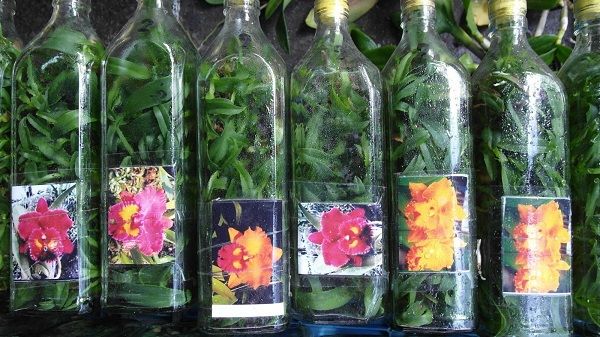

Flasked orchids.
The cost of a bottle of seedlings varies depending on the type of plants inside and their number. It can range from a few dollars and more, reaching tens and hundreds of dollars.
Advantages and disadvantages
The big plus of such a purchase is:
- relatively low cost of each individual plant;
- a large number of them;
- the ability to grow a plant that is fully adapted to the specific conditions of detention.
Also, sometimes it is only such an opportunity to purchase a copy of a particularly rare species. Purchase of a batch of flasks with orchids - a good help to start a business of reselling orchids.
Among the disadvantages are the reverse sides of the advantages. In fact, when making an order online, the florist plays the lottery and most often gets a "pig in a poke", because the seedling blooms only at 4-5 years of age.
That is, it is impossible to somehow be 100% sure of the honesty of each individual supplier, since he may simply by mistake send the wrong thing. And the florist learns about this only by the colors.
The exception is orchids, which have any specific distinctive features and features, but there are few of them.
A seedling was obtained from a flask: what to do with it next?
The extracted plants are washed in cooled, but still warm, boiled water. It is very important to thoroughly wash the remnants of the gel-like environment in which the babies germinated. The health of the plant depends on this, because in the gel or moss used, bacteria develop that can cause the disease of babies.
That is why orchids are thoroughly cleaned from the flask with a brush for painting or cosmetic. Once they are washed in clean water, the second - in a weak, barely pink, potassium permanganate solution, in other words, in potassium permanganate.
In order to prevent the defeat of fungal infections, many orchivods immerse the flasks for 15-20 minutes in a solution of fluconazole 150, prepared at the rate of 1 capsule per 1 liter of water, or in a solution of phytosporin at a concentration of 10 drops in 1 liter of water.
After such an intensive "bathing", the babies are laid out on a moisture-absorbing fabric with the roots up and left to dry for 4-5 hours.


Drying the seedlings after washing from the gel-like medium
Growing technology from imported seedlings
The sprouts are acclimatized gradually. Seedlings germinate under sterile conditions and do not have acquired immunity to various pathogens. Therefore, it is necessary to slowly accustom them to the harsh conditions of an open atmosphere. The best place to grow seedlings will be mini greenhouse, florarium or orchidariumwhere gentle conditions are maintained.
The removal of seedlings is carried out immediately before the procedure for transplanting young plants. Use a long tweezers or a hard wire hook for this. If the plants are kept in the nutrient mixture, you can draw water inside - the mixture will dissolve and the orchids can be poured into a basin with water. The plastic container greatly simplifies the procedure - it is simply neatly cut with a knife or scissors.
Transplanting seedlings for growing roots is carried out according to the same principle as planting an adult orchid for the purpose of resuscitation. That is, a thin layer of expanded clay is poured in a mini-greenhouse, and a pillow of wet sphagnum moss is placed on top, on which orchid sprouts are placed in the funnels.
The greenhouse is placed under a source of bright diffused light, the temperature inside is kept at 24-26 ° C, the relative humidity is> 70%. Watering is carried out as needed. It is necessary to remember about daily ventilation. Top dressing begins after the appearance of roots, is carried out 1 time in 1-2 weeks (1/8 of the indicated dose on the package).
When the roots are more than 5 cm long, the young orchid can be planted in a substrate or block like an adult plant. The size of the pot is chosen depending on the size of the young plant, and the composition of the substrate is based on the species characteristics of the orchid.
Orchid substrate and nutrient fluid
In the absence of soil, the root system of the flower still needs to gain a foothold in something, so good drainage is needed. Expanded clay, glass balls, polystyrene foam, perlite, diatomite, green mix are suitable, that is, those materials that do not rot in water.
As a substrate, the so-called semi-hydroculture, expanded clay is ideal - a porous material that can absorb and release moisture. Pour a layer of expanded clay on the bottom of the orchid pot so that it covers the holes. Plant the orchid vertically, arrange the roots roundly so that they lay down naturally, without kinks and entanglements.
Then add a thin layer of perlite, about 5-6 mm. Then - diatomite, previously soaked in water for an hour. On top is a layer of green mix. The ratio of the components is approximately equal. It is allowed to use one type of substrate, most growers choose expanded clay.
A glass orchid pot filled with a substrate with a flower installed in it is poured with water. It should not touch the top of the outlet, but be about 1 cm below it. You should take only filtered or settled water, and preferably rain or, if possible, melted water. These whimsical plants can only be fed with special nutrient mixtures specifically for orchids, based on the life cycle of flowers. Mix food with prepared water.
How to transfer an orchid from soil to water
If you decide that the orchids will be better in the water, the transfer to the “new place of residence” should be done gradually, otherwise the plant will experience stress and may die from the abrupt change in the “climate”. Step by step guide:
Cut orchid in glass
Cut shortened orchid stalks or individual flowers, when participating in compositions and bouquets, are sometimes equipped with special test tubes with water on rods.
Bringing home such a bouquet, before installing it in a vase it is necessary to pull the peduncle out of the test tube and refresh the cut with a sharp knife. This is done diagonally in order to renew the capillary system of the peduncle to absorb water.
Water must be used boiled or settled, room temperature... In order to extend the life of the peduncle and flowers, you can add a little alcohol or vodka to the water.
It is better to put the bouquet in shaded place away from heating appliances... Direct sunlight and high temperatures accelerate the wilting of flowers and the stalk itself. Decorativeness also depends on ethylene, therefore it is necessary exclude the proximity of the bouquet with food products, especially fruits.
As you can see, there are many nuances and you definitely need to know how to keep cut orchids in a test tube.
Pros and cons
One of the main positive aspects of using this type of container is, first of all, its decorative function, which serves as a real decoration of this beautiful plant. Besides, glass perfectly transmits light
, which is also important.
Besides:
- a wide assortment presented in stores allows you to choose a container for every taste and plant size;
- due to its weight compared to plastic pots, glass is quite stable;
- the absence of pallets allows you to easily and quickly rearrange the plant;
- in addition to light, the flower will receive a lot of air.
The main disadvantage of glass vases, a pot and other things is the inability to make additional holes at the bottom for drainage purposes. Accordingly, excessive moisture may appear. If the vessel is too narrow and tall, the plant will receive enough light, but not enough air.
, which will negatively affect its growth.
Possible problems and difficulties
If the reader nevertheless managed to purchase a plant in a flask with a narrow neck and did not bother to take it out in time and attach it somewhere, some obvious difficulties await him.
Problems with removing from the flask without damaging the leaves
The use of laboratory glassware or bottles implies notching the shoots before they outgrow the size of the neck. Then there is no problem and the sprouts are carefully removed with tweezers, shaken out or washed out with water. In other cases, it will be possible to extract the plants only by breaking off part of their organs or breaking glass.
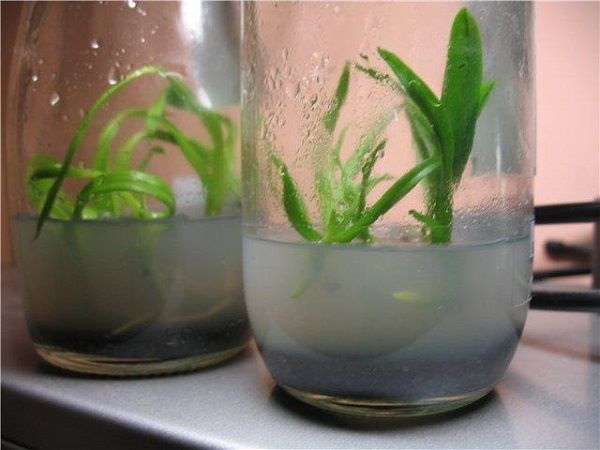

Removing an orchid from a flask is a rather laborious task.
Development of infections and fungal infections
Sterility inside the sealed container eliminates contamination. After unsealing, naturally inward air enters, which may contain spores of various microorganisms or fungi.
Airing and ventilation in such conditions is extremely difficult, and the stuffiness provokes the rapid growth of mold and the appearance of infections.
Shuffling content
The nutrient mixture inside usually keeps the orchids in a stable position. However, in case of accidental movements, especially during transportation, there is a high probability of mixing everything inside, as well as damage to young plants.
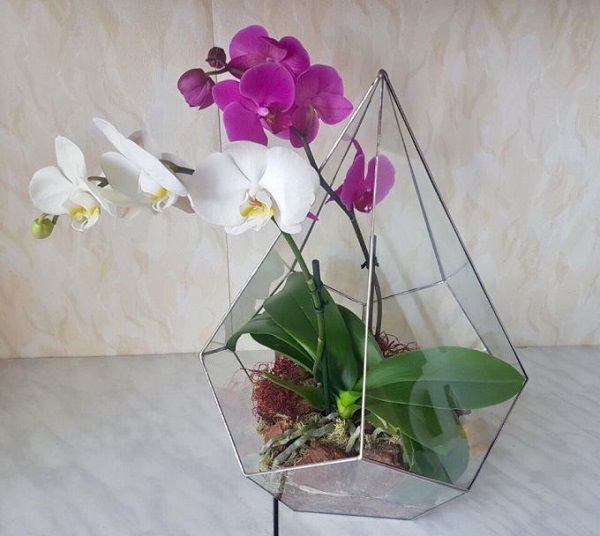

Care must be taken not to mix the contents of the flask.
The growth of the crown rests against the vessel wall
If the florist's negligence eventually reaches this size, there is nothing left but to be careful. break the container and plant the plant in accordance with the requirements and specific features.
Description of the cultivation method
When choosing a flask for transplanting an orchid, special attention is paid to the bottom of the container; glass-shaped containers, truncated flasks and cylindrical vessels are best suited. There are several reasons for this:
- Folded leaf plates are fraught with creases and death. To avoid these problems, it is worth choosing a wide vessel.
- The increased humidity inside the vessel is maintained by the closed vessel. This can lead to the development of a fungus.If there is no substrate in the flask, then watering must be done outside the container.
Influence of the microclimate of the flask on the plant
Narrow-necked dishes are used for germinating orchid seeds. She is not intended for permanent cultivation of orchids. Obviously, the stale air and the microclimate of the bathhouse inside are absolutely unsuitable for a plant whose genes are designed to exist in opposite conditions.
Ultimately, the florist is faced with a dilemma: break the container and plant an orchid normally, or, never waiting for flowering, watch how fungi and bacteria rot it.
Features of the development and growth of a plant without land
Wanda is a monopodial epiphyte, less often lithophyte, and she feels great with bare roots without soil... Usually it has a powerful system of airy, velamen-covered roots of gray-green color. In nature, she clings to them, holding on to the support.
It should be understood that wandas are tropical plants and they live in a very humid climate, extracting moisture and nutrition with all parts of their body from rainfall and air.
In indoor conditions, the plant should recreate similar conditions. And if the bulb takes care of the humid microclimate necessary for the air roots, then the florist you will have to feed the wanda a little more often than other orchids.
How to choose cut orchids for long-term storage?
Let's take a closer look at how to care for cut orchids. When choosing cut orchids, first of all pay attention to appearance flowers and buds:
- The color of the buds must be clean;
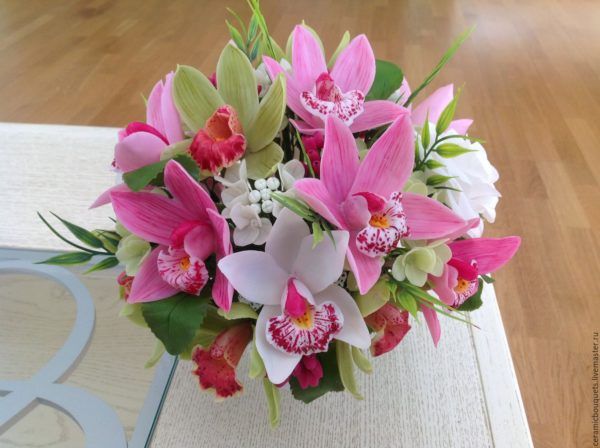

The freshest and whole orchids are chosen for the bouquet.
This knowledge is enoughto choose a fresh and attractive orchid bouquet.
Cause of premature wilting of flowers in a vase are bacteria and fungithat clog the conducting vessels of the stem. Therefore, the main task is to prevent the development of microorganisms and slow down the course of putrefactive processes.
Removing the bouquet from the package
Immediately after purchasing or receiving flowers exempt from packaging... It should be borne in mind that a sharp change in temperature for orchid petals is more dangerous than being without water, therefore:
- Flowers brought from the cold are best kept in a warm room for one hour without unpacking;
- The cut orchid is sold with a water-filled capsule in which the flower stalk is immersed. It is only needed for transportation, then the capsule is removed.
In the future, actions are taken that allow extend the life of a cut plant.
Stalk washing and pruning
Extracted peduncles washed with fresh water, then immersed in water and cut with an oblique cut to a height of 1-2 cm. This will open the conductive system of the stem and prevent the rapid growth of bacteria in a vase of water.
Placement in a vase
To keep cut orchids fresh for as long as possible, you need adhere to the following rules:
- Use rain, thawed or mineral room temperature water, since hard water does not go well into the conducting vessels of plants. If they take water from the tap, then it is better to boil and defend it;
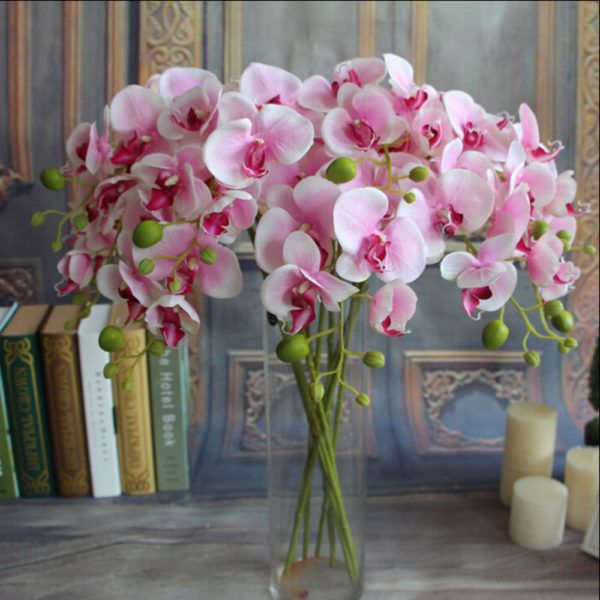

Pour water into the vase to keep the cut orchids looking good.
Correct care will prolong life cut orchid up to 25 days.
Optimum temperature
Low temperature and high room humidity, as well as a semi-shaded area contribute to:
- Minimal evaporation;
- And the maximum flow of water into plant tissues.
To keep the bouquet fresh as long as possible, it is proposed two options for night care:
- At night, the flowers are transferred to a cool place with a temperature of 10-15 ℃;
- In the evening, the flowers from the vase are placed in a bucket of water, covered with wet gauze on top and the ends are dipped into the water.
it promotes freshness and decorativeness of cut orchids.
Where to place it indoors?
The bouquet is better do not put on the windowsillto protect from direct sunlight, heat from batteries and possible drafts. Cut flowers prefer a cool, shaded area.
Why is it not recommended to touch flower petals?
Considering a beautiful flower, it is advisable do not touch its petals and especially the head of the pistil, under which the pollen is stored. Its loss leads to the rapid wilting of the flower.
Spraying
Unlike many other flowers, cut orchids should not spray.
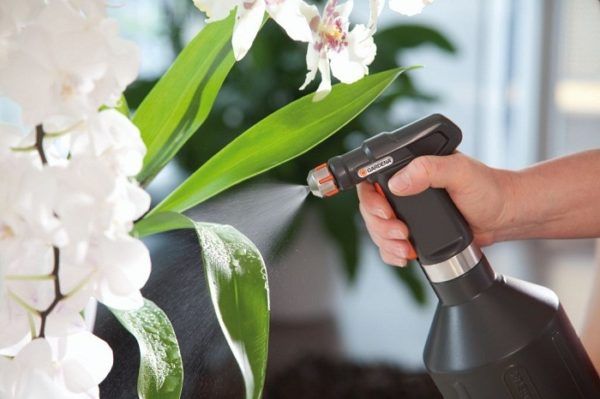

It is better not to spray cut orchids.
Moisture contributes to the formation of brown spots on the petals.
Do I need to transplant?
In one small vessel brought from Asian countries, upon arrival home, they find not one orchid, but several dozen seedlings. Do I need to transplant them from a flask into regular pots? Yes, they do it not earlier than 2 weeks after arrival.
An orchid transplant from a flask is carried out in stages:
- "Acclimatization" after the trip to relieve stress. The flask is placed on a windowsill, which is immersed in the rays of the sun, where it will be warm and there will be no drafts. The optimal period of "acclimatization" is 10-14 days.
Reference! Do not wait two weeks if the flask is turned over during transportation and the contents are mixed. They do the same if the seedlings rest against the top of the container lid. - Transplant with precautions.
- Organization of proper care.
Extending the life of the bouquet
How to keep a bouquet of orchids alive longer? Adding to water various chemicals able to extend the life of orchids in a vase.
Traditional methods
It has long been known the influence of various dressings and disinfectants for the cut flower:
- To disinfect the water, add several tablets of activated carbon or a silver coin;
- Effervescent aspirin (one tablet per 10 liters) disinfects water and accelerates its absorption by the stem cells;
- To limit the growth of bacteria, vodka is added to the water (50 ml per 1 liter);
- Sugar (2-3 teaspoons per liter of water) will provide the flowers with nutrition;
- 2-3 tablespoons of sugar and boric acid at the tip of a knife, added to a liter of chilled water, will ensure water disinfection and plant nutrition;
- 50 g of coniferous concentrate and 50 g of sugar.
This will help the orchids stand in a vase more than one week.
Special means
Numerous formulations have now been developed to keep cut flowers fresh, These include:
These drugs include both disinfectantsand nutrients.
When used correctly top dressing helps to extend the life of orchids in a vase up to 20-25 days.
How long will a cut orchid last?
The lifespan of cut flowers is different for each orchid species. She is depends on genetic characteristics plants, the phase of flower development at which the cutting was carried out, the conditions of maintenance and the method of processing the bouquet:
- Cattleya flower stalks will stand in the cut for about one week;
- Papiopedilum - within 20-30 days;
- Cymbidium will not lose its decorative effect for a month, while a single flower can stand in the cut for more than 10 days;
- Phalaenopsis peduncle retains its fresh appearance for about 20-30 days.
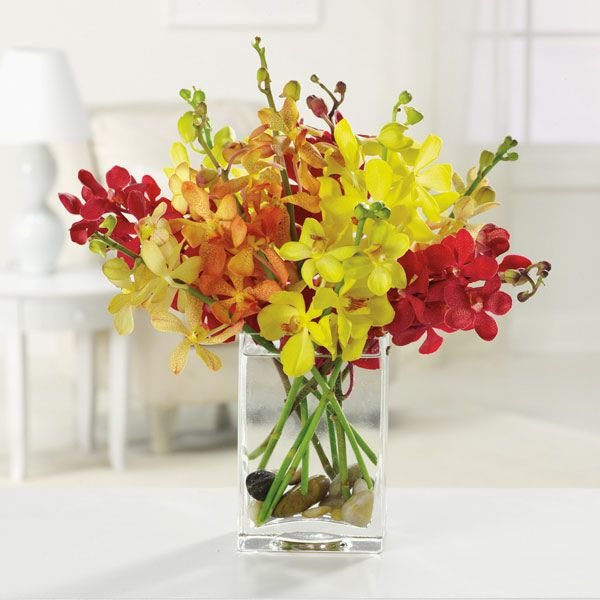

Different types of cut orchids stand in a vase in different ways.
Orchid monobouquets keep fresh for a longer time, since they do not have aggressive factors.
Types of containers: vases, pots, flasks
Currently, a huge number of all kinds of options for such items are presented, however, the most common and widely used ones can be distinguished:
- vases of various shapes and heights, including square and spherical;
- pots;
- glass flasks;
- models in the form of small glasses, bowls and glasses.
Such glass containers look very stylish and impressive
... They can easily complement any interior and become a highlight of the room.
Features of the choice of packaging
- For tall plants, it is important to choose a vase according to the growth of the orchid, making sure that its leaves feel more or less free, and the bottom of the vessel is quite, but not excessively wide. It is imperative to arrange ventilation so that there is no stagnation of air.
- Orchid pots should be medium in size.
- As in the case of a vase, the flasks should be chosen according to the growth of the plant, and due to the rather narrow shape, plants with weak roots can be planted in it. It is also necessary to ventilate.
- For miniature, small orchids, different types of "glasses" and "glasses" are suitable.
The type of plant is also important. So, the most suitable for planting in glass are phalaenopsis and wanda
... Repotting is best after flowering.
The choice of vessel volume depends on the size of the roots, and the height depends on the growth of the plant. It is possible to plant several orchids in one container in case of sufficient volume and size of the vessel.
It is best to choose such a container option so that the roots of the plant are inside, not too loose, and the leaves and flowers are outside. So it will be more convenient for the flower itself, and it is easy for a person to take care of it.
Transportation
Cut orchids are delivered to our stores not only from Europe and Indonesia, but also from Australia and Latin America. These flowers require special handling during transportation, which largely depends on the duration of their life in a vase.
Fundamental rules
These rules suggest:
- Transportation of cut flowers over long distances in capsules, when the stem is constantly immersed in a container of water;
- The minimum cooling temperature for peduncles is 8-10 ℃. At lower temperatures, which are maintained in a household refrigerator, the flower will die instantly;
- Before long-term storage in the refrigerator at 8-10 ℃, the flowers are kept there for one hour without packaging to prevent moisture condensation harmful to flowers.
Compliance with these rules will allow you to transport the orchid to the right place without loss.
Step-by-step instruction
Landing
We present step-by-step instructions on how to plant an orchid in a glass vase, pot or other container. Before the planting procedure, it is necessary to process the container by pouring boiling water over it
and thereby disinfecting.
- Put a thick layer of gravel on the bottom: expanded clay, small tile fragments, pebbles, crushed stone, and so on - your choice. This will be the drainage. You can add a layer of sphagnum moss on top.
- Then add a good substrate to fill the entire space.
- Defend the water, slightly heat it to a warm state and pour it over the contents of a vase, pot or flask.
- After half an hour, pour out the water and plant in the ground. Cover the bark surface with a thin layer of moist moss, making sure that the root collar is not filled with it.
We offer you to watch a video about planting an orchid in glass:
Care
The main rule of care in this case will be correct watering, in which the roots should be immersed in pre-settled warm water for half an hour. Protect the flower and leaves from such water procedures.
The orchid can be sprayed. This is the best way to water it. The spraying frequency depends on the humidity in the room. So, for example, in the winter season, when the air is dry, this procedure can be carried out once a day.
No less it is important to feed and feed the plant as it grows
by adding mineral fertilizers to the water for irrigation.
If the roots have dried out for some reason, and this problem is often found in purchased orchids in glass pots, they should be kept in settled warm water for 10-15 minutes once a day, repeating the procedure daily until the dryness is eliminated.
The water level is clearly visible in glassware
, therefore, it is not difficult to monitor the degree of humidity, but it is important to remember that the soil dries out from above much faster than inside, especially when it comes to glass containers.
We suggest watching a video on how to properly water orchids in glass:
Cutting rules at home
On the left, you can see a cut of an orchid in the photo. Cutting of the peduncles is carried out after the full opening of the flower, in the morning, when the plant cells maximally saturated with moisture:
- The manipulation is carried out with a sharp knife, the cut on the stem is made oblique;
- Then the flowers are placed in a deep container of water for several hours and placed in a cool, shaded place.
This is necessary so that the plant cells are saturated with a sufficient amount of moisture and acquired elasticity.
Slicing processing
Many beginners ask the question of how to process an orchid cut at home? After cutting the peduncle, the remaining stump is covered with crushed activated carbon or cinnamon.
General form
A glass container looks quite aesthetically pleasing, transmits light, and a plant placed in such a container looks very nice and original.
Glass vases, pots and flasks for flowers come in the most shapes and colors:
tall and elongated, widening downwards, rounded, cup-shaped and cup-shaped, from completely transparent to slightly darkening of color: light blue, light green or light yellow. This variety allows you to choose the most suitable type of container for a particular plant.
As for the flower itself, it can be of all kinds of colors: from bright white, milk and cream to rich purple, red, pink and blue.
Photo
We present to your attention a photo of orchids in glass containers.
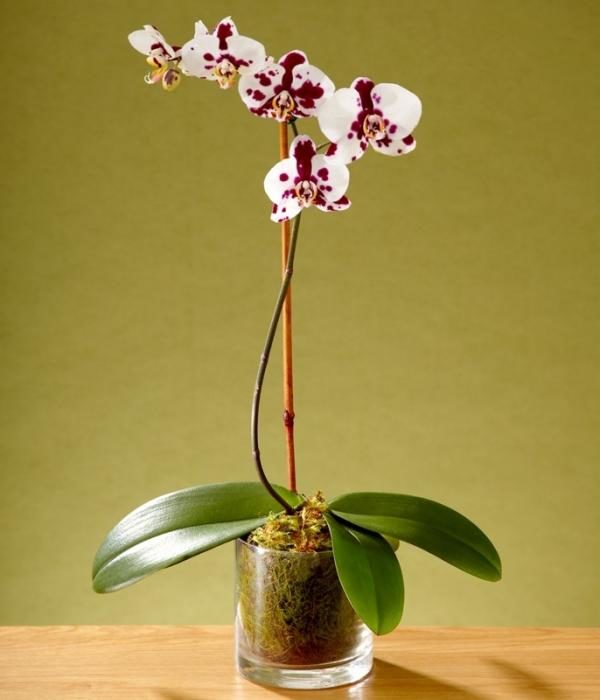

How much does a bouquet of orchids cost?
How much does a cut orchid in a bouquet cost? Such a bouquet is worth buying only from trusted florists, to be sure to the end of the life of the orchids. The price for them can be very different and range from 80 rubles. up to 2 thousand rubles for one piece:
- The price is primarily influenced by the type of orchid, the more exotic the flower, the higher it is valued;
- The time of cutting flowers also affects, the fresher the bouquet, the more expensive it is.
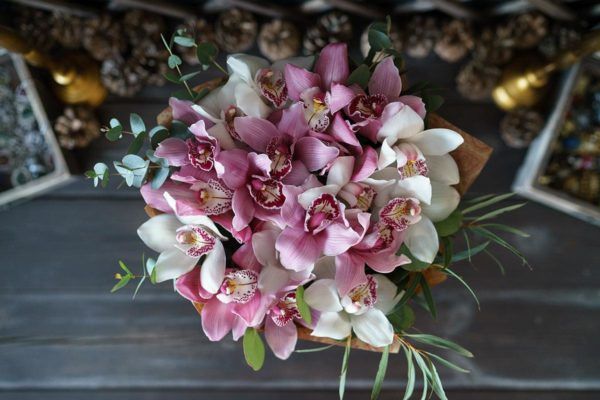

The fresher the bouquet of orchids, the more expensive it is.
With proper care, a bouquet of orchids will bring a lot of joy and will delight you with its exquisite appearance for a long time.
Where to buy suitable cookware
A huge assortment of glass vases, pots, flasks and cups for planting and growing flowers can be found in the Ikea network in all cities where this company is represented. Price from 90 rubles for a small pot.
Glass containers for flowers of a slightly higher price category can also be found in Zara Home stores. Here the minimum price is about 2,000 rubles for a medium-sized vase.
Specialty shops also have a variety of beautiful glassware for flowers.
and plants. Prices start at 150 rubles.
In addition, there is always the opportunity to purchase the item you like online in flower shops. The cost starts from 200-300 rubles for a small glass glass and from 700-800 rubles for a tall vase.
An exotic orchid flower, enclosed in an elegant glass vase or pot, will become a real decoration of the house, and although this plant requires constant care and some experience in growing flowers, it is not at all difficult to provide it with all the conditions for favorable growth and flowering.
Often, plants in this form are cultivated in Asian countries, where they are already sold in this form. It is important to understand that the narrow glass container in which it is sold cannot be used for a long time, since the plant in this form will not last long. The glass container usually contains not an adult plant, but seedlings
.
ATTENTION
: The most common for this kind of keeping is the Wanda orchid. Phalaenopsis can also be grown.
But we will talk specifically about the Wanda orchid.
Vanda orchid has a strong root system
... The root can be up to 2 meters long. The roots are thickened, grayish-green in color and covered with a thick layer of velamen. The stem of this flower at home stretches up to 1 meter in length, and in nature up to 3 meters.
The leaves of the flower are large and not closely spaced and two-row. They are leathery and fleshy and bright green. The flowers of the plant can have a color:
- snow-white;
- cream;
- lemon yellow;
- Orange;
- cherry red;
- light pink;
- rich crimson;
- purple;
- violet blue.
In what container should the plant be kept?
When growing an orchid without soil, the moist moment is choosing the right pot. For this plant, it is worth choosing a container of this type and structure so that the flower has a place to develop, does not dry out and does not undergo the harmful effects of dry air in the room where the plant is kept. Choosing a pot for growing without land, glass vases or plastic and ceramic containers should be preferred. In addition, they must meet the following criteria:
- The containers must have a drain for water.
- Pot size and plant size must match.
- The volume of the container should be such that the root system of the plant can freely settle there and does not touch the walls.
We offer you to watch a video about choosing a container when growing an orchid in an open system:
Capacity requirements
Before you grow a plant, you need to choose the right container in which you "put" the flower. This is one of the most important procedures, since due to improperly selected capacity, the plant may die
.
The form
The most suitable is the one with a narrow top and, on the contrary, wide at the bottom. They resemble a glass by their shape.
Avoid using tall cylindrical containers, despite their attractiveness.
... In such containers, the leaves are often bent and broken, from which the orchid may die. Do not forget that only the roots of the plant are in the container, while the leaves are located on top.
Glass containers provide the roots with plenty of light. However, their main advantage is their decorative properties. However, the use of such containers requires a lot of experience in caring for orchids. All due to the fact that there are simply no drainage holes in the glass container. Therefore, it is quite easy to get an excess of moisture for the roots, which they do not like very much. This leads to their decay and death of the flower.
IMPORTANT
: Also, in such a container, the plant will not receive a sufficient amount of air, and from this, algae will appear on its walls.
If you do decide to use a glass container, then you must take care of a lot of drainage and the right substrate. And it's easier to put a plastic pot with a plant in a glass container of your choice.
.
But there are also disadvantages of growing an orchid in a glass vessel.
:
- Excess moisture is possible.
- Small amount of air for the flower.
- Additional drain holes cannot be made.
- It is difficult to choose the right shape so as not to harm the flower.
Design
- Beautiful vases.
- Flasks.
- (read about which pot is better to choose - transparent or not).
- Glasses (for small orchids).
- Glass mugs.
What container is suitable for planting a Wanda orchid?
The rules of care also apply to the selection of a suitable container, since not every container can be suitable for an orchid. Wanda feels most comfortable in a hanging basket or a pot with side holes where the rhizome penetrates.
Today, in various retail outlets, you can more and more often find the beautiful Wanda, located in a vase. Moreover, it does not contain any soil mixture or substrate. Wanda in glass is often purchased as a presentation. For a flower, you can choose a container from this material of any shape. But it should be borne in mind that the vanda orchid in a glass vase, sold unopened, is prone to quick death.
Advantages and disadvantages
Growing an orchid without soil has the following advantages
:
When growing orchids, an open, automatic type system is used, thereby reducing the time spent on caring for the flower.
Only it is important not to forget to add water from the irrigation system when necessary
.
Thanks to this method, the orchid will no longer need watering for 2 weeks, and this will not harm it in any way.
As for the disadvantages of the method, there is only one here - these are difficulties in leaving. Because of this, the appearance of the flower begins to suffer, as its leaves turn yellow and fall off, the root system rots.
Special Requirements
If you want to grow your flower in a glass pot, then you must:
- Choose a healthy plant.
- Take care of good drainage in the pot.
- Find a good substrate.
- Strictly control watering.
A glass flask is far from the best option for growing orchids. They have a narrow cylindrical shape due to this, the leaves of the growing flower bend and break. And the flower dies. Same in a tall flask, moisture will not go well and a sufficient amount of air will not flow
, and this is a direct path to fungal diseases and root decay. Therefore, you should not choose glass flasks for your pet.
TIP
: As for vases, the best option is a glass-shaped vase, wide at the bottom and narrow at the top. When planting in a vase, be sure to remember that there are roots in the vase, and the plant itself is outside.
Watch a video about planting an orchid in a glass pot: Where can you buy?
You can buy glass containers for orchids at any specialty store.
... The seller will help you choose the best option. You can also order containers via the Internet. Cost on the Internet from 190 rubles, and in stores - from 140 rubles.
If you want to have an unusual decoration in your home, then definitely choose an orchid in a glass container. The main thing is to familiarize yourself with all the requirements of the plant and then you will succeed.
Orchid in glass is original, unusual and beautiful. A flower placed in such a pot can be presented to a friend, or it can decorate your own room. Due to the tightly sealed lid, the water does not evaporate, which means that there will be no need to constantly add liquid.
Often, a plant in a flask is found in Asian countries, where it is very fashionable to purchase orchids in this form. True, it should be understood that using a narrow transparent container (in which the beauty is sold) will not work, because, despite good care, the flower will not last long in this state.
Usually a plant in a glass flask is a seedling, not an adult flower, so those people who want to try themselves in the role of gardeners can pay attention to just such options.
In a vase - not uncommon, in fact, like phalaenopsis. Usually, the presented type of flower is acquired in order to decorate the interior of an office or living room. The popularity of the variety is growing every year, which is not surprising. This trend is due to the appearance of the beauty, which boasts at the same time unusual large flowers.
Another advantage is that this plant does not need any special care, it perfectly adapts to the microclimate of the rooms, where it finds a “new home”.
Wanda in glass, or rather blue wanda, is a particularly popular flower that is hard to take your eyes off. Its sky-blue inflorescences are simply mesmerizing, prompting you to admire this exotic again and again. True, caring for this plant is more difficult than other species.
When choosing a vase, they attach great importance to the bottom of the container. The best option is a glass-shaped flask. Although on sale you can find a variety of flasks. Experienced gardeners pay attention to truncated flasks and cylindrical vessels. This interest is due to the complexity of keeping orchids.
There are several reasons for this:
- The lower leaf plates are folded, and this is fraught with kinks, kinks and death.
- Due to the fact that the glass container is constantly in a closed position, high humidity remains inside, and this leads to the development of fungal and bacterial diseases.
As for the first case, more spacious vessels should be chosen. In the second, everything is a little more complicated. If the capsules do not contain a substrate, then the orchids should be watered outside the container. To do this, the flowers are immersed in a separate bowl of water, leaving them for a few minutes, and then the plant is dried and placed back in the vases.
Difficulties
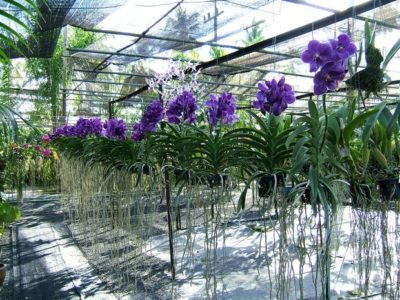

Any difficulties may arise if you do not follow the rules for caring for the orchid. The most common problem remains, associated with the desire for a leaf plate, as a result of which the leaves simply fall off. But it's one thing when this is a natural process and old leaves fall off, but this can happen to young ones for the following reasons:
- waterlogging - along with the yellow leaves, the process of rotting of the root system occurs;
- overdried soil - a common cause of wilting of leaves, this occurs if the plant is not sprayed, and the air in the room is not humidified;
- direct sunlight - in the summer, they can lead to the development of such a negative phenomenon;
- draft or cold room in winter.
Growing an orchid without soil is an interesting activity for every grower.... But here there are a number of points, without which the flower risks perishing. So, only experienced people need to choose this way of growing in order to prevent problems in the future.
If you find an error, please select a piece of text and press Ctrl + Enter.
Professional tips and secrets
What if the root system is very weak?
You can help the plant grow a lush root system using the instructions root or its analogs.
Ventilation, aeration of the plant
Although Wanda is native to the tropics, it prefers fresh air. therefore it is necessary to periodically ventilate the plant.
It is necessary to place it in a flask so that air can freely circulate and get inside.
The size of the container in which the wanda is contained must be large enough to the roots were freely placed inside.
Disinfection of the container
Unfortunately, over time, a glass vase from the inside becomes covered with a layer of algae or a layer of salt. therefore the flask will have to be washed constantly... You can disinfect with a weak solution of potassium permanganate. The plant, of course, should be removed from the vase during this procedure.
Transplant to hydroponics
An orchid without soil can be actively growing in a vessel with hydroponics, a solution that has the necessary nutrients added in precise proportions. Such placement allows you to go on vacation for a short time and not worry about the fact that the roots dry up and the pet will die from a lack of moisture and water.
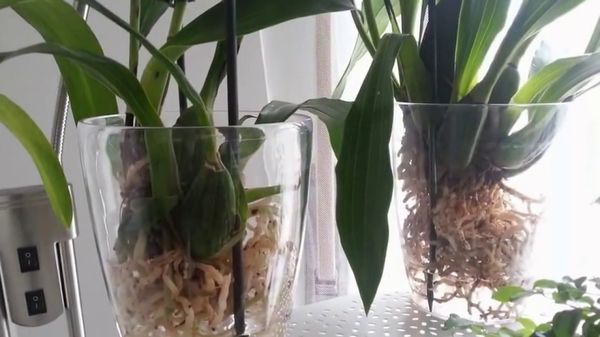

The advantages of the method:
- Lack or excess of fertilizers is excluded.
- The formation of pests, rot and other similar problems is categorically impossible.
- Such orchids in a vase do not need replanting.
You may be interested in: How to care for orchids in a pot after purchase Why orchid leaves wither and how to save it Features for the care and reproduction of Dendrobium Nobile orchids
Growing an orchid in water is quite simple, but many people prefer to plant it in a substrate consisting of the following components:
- Expanded clay, designed specifically for plants and its size should be 8-14 mm. Rinse the material thoroughly and rinse with running water before use.
- Perlite, fraction 3-6 mm, with capillary properties.
- Diatomaceous earth is large, medium and small, which is capable of absorbing 150% of the liquid, which is more than its own weight. Soak it in water for 1 hour before use.
- Greenmix. Composition - mineral moisture-absorbing and water-repellent wool in combination with perlite.
To grow an orchid and take care of it at home, it is worth purchasing a plant from a specialized store, where they can offer healthy and non-infected sprouts. Some people prefer to order online. But, you need to be sure that the supplier is proven and sells flowers that meet the stated specifications.
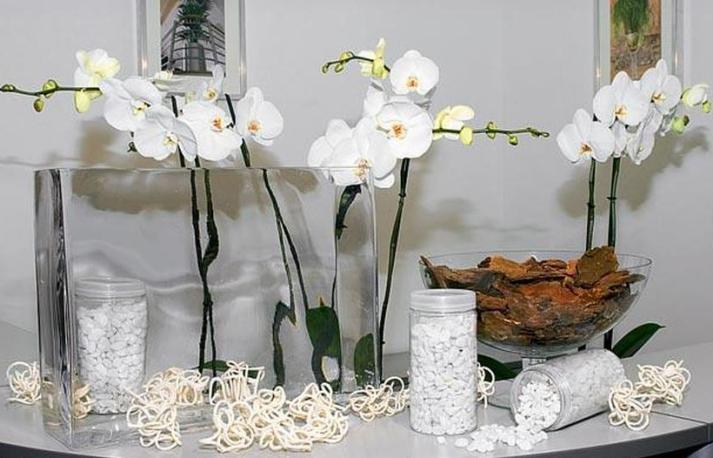

An orchid in a glass vase without earth is an unusual way, but it is with its help that you can make a collection of plants more original. Those who already use such containers confirm the fact that they are more elegant and can be used as the centerpiece of the entire composition. They are eye-catching and rave reviews, especially if Wanda is in full bloom. Accordingly, before cultivating an orchid, you need to weigh the pros and cons.
Humidification and ventilation
When asked how to care for an exotic plant, novice growers receive the answer that in addition to a large amount of light and temperature conditions, humidity levels are important for it - within 50–70%, as well as regular ventilation. Since the higher the humidity in the room, the easier it is to care for bare roots. Normal air circulation is also important. Since this type of orchid reacts negatively to its stagnation. The roots need to be able to breathe freely.
Growing difference
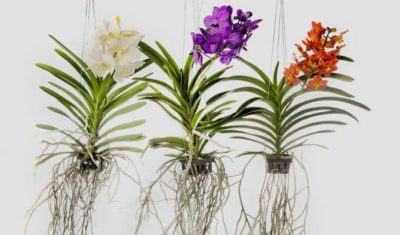

Using this method of growing orchids, you need to be more careful and responsible in the care process.
Unlike the traditional method, in this case it is not necessary to select the soil or prepare it yourself, which saves time and money. But more increased requirements are imposed on the growing conditions: suitable humidity, timeliness of watering.
And the most important difference is that an orchid grown in soil is much less likely to get sickthan the one for which the soil mixture is not used.
We offer you to watch a video about the difference between growing an orchid in a closed and open system:
Wanda is a stylish beauty in a dignified vase frame.
Wanda in a glass vase is a great decoration for a stylish interior. Possessing large, spectacular, very unusual flowers, the vanda orchid is so attractive that it is becoming more and more popular. She quickly adapts to the microclimate of our rooms. The most famous "Vanda blue", which has stunning beautiful sky-blue flowers.
Only with its high-quality and competent content will the plant live for a long time, bloom, delighting its owner with healthy leaves and roots. If you have to choose vases, it is best to opt for the shape of the so-called "glasses", which are wide at the bottom, narrower at the top.
The vessels in which the wandas are sold can be conditionally divided into low, wide and those in which the height prevails over the width. The latter - vases in the form of cylinders or truncated flasks require increased attention to the content of plants in them for the following reasons:
In a cylindrical vessel, the lower leaves are in a folded state, their creases, bends are possible, which is fraught with their loss. Excessive moisture inside the flask, lack of high-quality ventilation sometimes leads to the appearance of bacterial and fungal infections that affect the roots and leaves of the orchid. To prevent this, vandas, which are often contained in such glass containers without a substrate, are watered not directly in it, but by taking out and immersing in a separate container with water. After drying, the orchid can be returned back to the vase.
If you are satisfied with the vase, you just need to raise the plant with flowers above the edge of the decorative vase so that the roots remain inside, and the peduncle with leaves is outside. Then it will be more convenient to take care of the plant, and the flower will feel better. If Vanda is contained in the substrate, it should be sprayed more often with a systemic fungicide, becausein the absence of holes in the glass vessel, it is practically impossible to ventilate the entire depth of the vase.
What is Wanda sick with?
Diseases affecting indoor vegetation do not bypass this exotic flower. Excessive moisture in the soil or air leads to the development of "spotting". The aching flower has warty spots at the bottom of the leaves.
Often, orchid disease is caused by fungi that grow well in warmth and humidity. They form round-shaped black spots on the upper part of the leaf. To save Wanda from spotting, you need to take care of more favorable conditions for her growth.
You can protect the flower even during planting by treating the soil with disinfectants. To do this, you can add drugs with antifungal action to the water. Excessive moisture in the substrate can lead to rotting of the plant - both the stem and the root system. Such processes are significantly enhanced in cool weather or when an unsuitable container is used as a container.
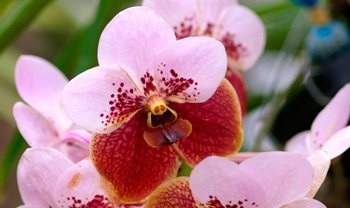

If individual parts of the plant become softened and become black, then one should expect its early yellowing and death. In this case, disinfection of the substrate will help, as well as watering the orchid with water with a dissolved fungicidal agent "Maxim". In addition, various pests “love” the orchid:
Breeding the Wanda orchid is not easy. First of all, it is necessary to cherish a love for floriculture, to be able to take care of your wards, taking into account their needs. And then the result can exceed all expectations!
It is impossible to be indifferent to houseplants. In every apartment or house there is at least one green miracle that creates coziness. The orchid flower is amazing in its beauty and is popular, and the vanda in a glass vase is an original unique gift, a stylish decoration for any interior.
Which vases to give preference to? The most convenient vases for growing orchids are narrow at the top and wide at the bottom. Such vases resemble a glass in their shape. Tall cylindrical vases are less popular among flower growers - in them, the leaves of the plant are often bent and broken, which in most cases leads to the death of the flower. Please note that only the roots of the plant should be in the vase, and the leaves are on top.
What is used instead of soil?
The orchid feels great even not in the soil saturated with humus, but on the trunks, branches, roots of a tree. The components necessary for the development of a flower are not obtained from the soil at all.... The atmosphere remains the food source.
An orchid needs soil only so that it can somehow gain a foothold and hold on to a certain area. So when choosing components that will be used instead of soil, one must take into account their permeability to moisture and air.
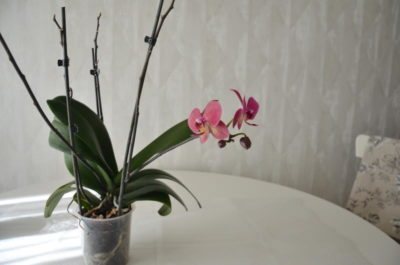

In most cases, tree bark is the main component for homemade soil mixtures. It can be torn off with your own hands or purchased from a specialized store. Most often, flower growers choose precisely pine bark, although the bark of oak and conifers is excellent. To collect it, you will have to use sawn logs or dead wood.
To keep the plant safe and protect it from pests and bacteria, pieces of bark must be cleaned of the softened area and dried thoroughly.
In addition to the bark, flower growers actively use sphagnum moss as soil. Its main purpose is to make the soil loose, retain moisture without compacting the soil, absorb harmful salts and have a bactericidal effect.
We offer you to watch a video about the types of soil for growing orchids:

